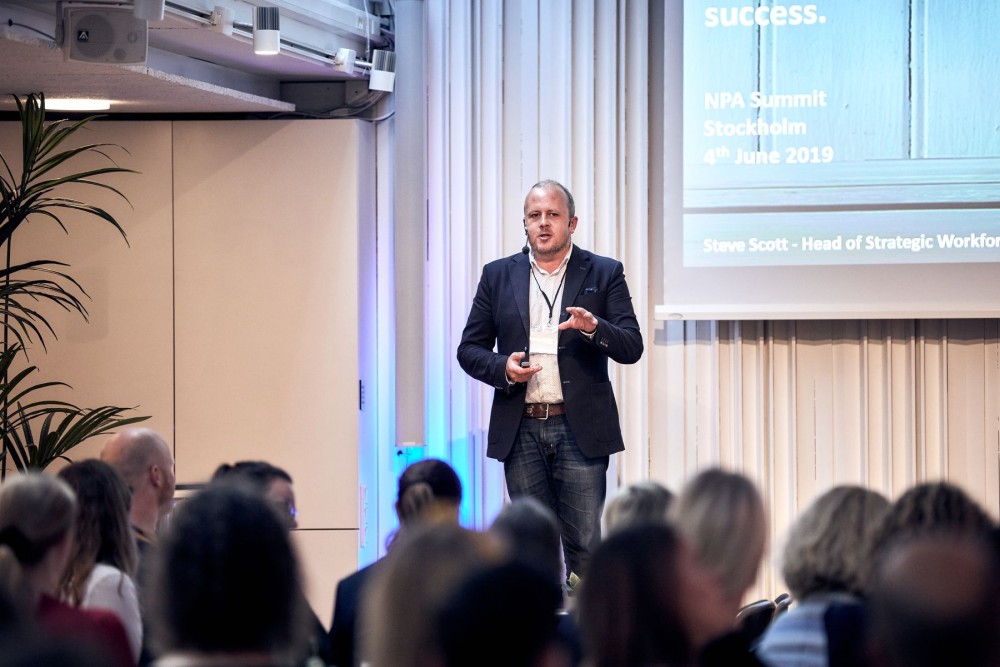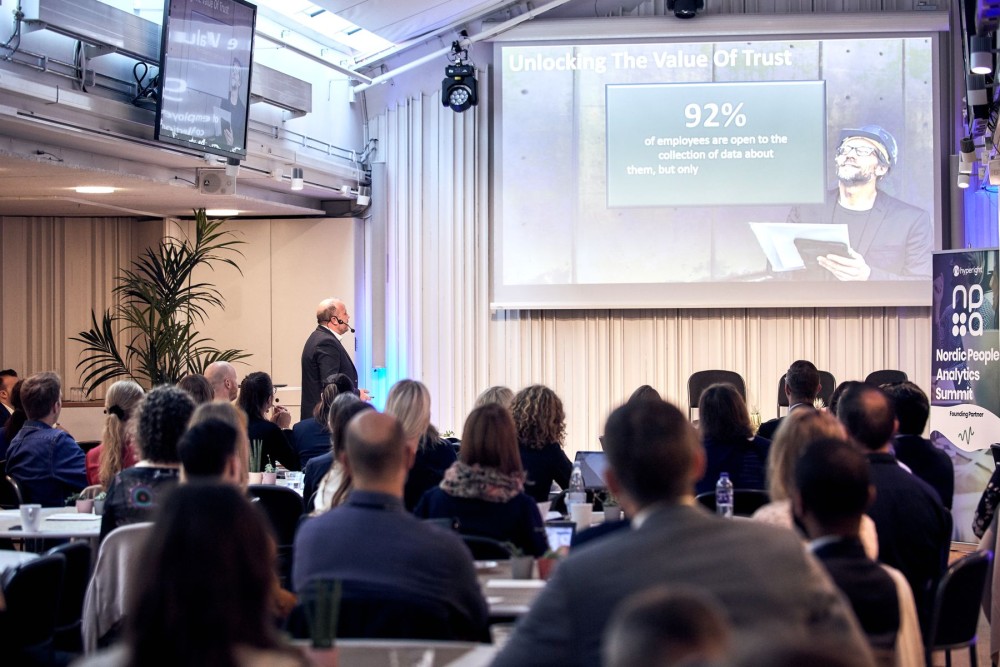As companies are starting to turn to data and analytics to optimise HR processes and drive business change, it’s undeniable that they are up for many trial and errors along the way. This is why we present experiences of people analytics practitioners that have pioneered in the people and workplace analytics domain to serve as a beacon for those just setting out on this journey.
Steve Scott, former Head of Strategic Workforce Planning and Workforce Analytics at Lloyds Banking Group, gave some tips and hints he wished he had known when he was starting out with people analytics during his presentation at the Nordic People Analytics Summit 2019.


The value of unlocking and trusting workforce data
Before revealing his hints, Steve proposed that it’s helpful to ask ourselves why even start with people analytics and what value we would get. For him, people analytics is all about unlocking the value of trust. Steve shared some figures related to workforce data that highlights the importance of implementing people analytics to build trust.
Learn more about the Nordic People Analytics Summit
As he points out, 92% of employees are open to the collection of data about them, but only if it provides personal benefits. Curiously, employees are more open to sharing their skills and backgrounds on LinkedIn than with their own organisation. “That’s because there’s no fair exchange of value,” clarifies Steve. As a comparison, in the role of consumers, we happily share our information with big companies like Netflix or Amazon so that they can recommend products. But in the workplace, we don’t see the same exchange – colleagues are resistant to give their data.
But if employees see that they’re getting some value in return for their data, such as training, skill upgrades, recommendations on open positions, we would see some progress in establishing trust.


Next, 30% of business leaders think they are very confident they are using workforce data in a highly responsible way, which means that the overwhelming 70% don’t. Additionally, 64% of employees state that scandals about the misuse of consumer data have made them concerned that their employee data could be misused, which is why integrating data privacy and ethics from the very beginning should be the highest priority.
But, if we manage to build trust with our employees to share their data at the workplace, Steve states that the opportunity, or ‘Trust Dividend’, is more than 3 trillion dollars worth of value that exists in public limited companies by using workforce data responsibly.
The Framework for Success with people analytics
To help him establish the people analytics and develop a team around it, Steve created a framework that guided him through the entire process. He shared it as his practitioner’s perspective based on his first-hand lesson learnt.
Steve disagrees with guidelines suggesting incremental steps to reach maturity. The reality is, there just isn’t enough time to take this approach. Instead, he proposes that companies go for organic growth where they have the vision of the end state in them but don’t rely on incremental steps to get there. A more realistic approach is an agile approach with quick wins that will provide results faster, argues Steve.
Steve’s framework enables creating a successful and high performing team in people analytics – a team that drives a real impact. It consists of several building blocks which he explained in detail.


Operating model
The operating model is connected to the operational design and processes which refer to where the people analytics team sits in the organisation, who they report to, the scope they cover, the culture, the level of control and guidance in the organisation. The relation to other enterprise-wide analytics teams is also crucial. Besides workforce analytics, there might be risk analytics, customer analytics, etc., and there is a great opportunity for knowledge sharing among different analytics teams. Also, the team needs to identify what its core vs non-core activity is, so they don’t drift off doing stuff that doesn’t add value and create impact.
Regarding processes, some important points that Steve outlines are generating demand for projects on a pull or push basis – whether they should ask people what they need or find opportunities in analytics themselves. The key is for the people analytics team to be included in organisation-wide alliances and not be separated into a silo department.


Data and Analysis
In terms of data, looking at only people data might not provide the right answers. If the team seeks to solve business problems apart from people problems, they need non-people data like operational, finance, customer data; and they should be able to combine these two to deliver impact. It can be helpful to look into external and benchmarking data. Moreover, people’s data is really sensitive, so data access and security should be thoroughly defined. Companies should make data quality, accuracy and availability the top priorities.
Steve states that following the descriptive, predictive and prescriptive order of analysis isn’t imperative. He affirms that all can be done at the same time depending on the needs and goals. However, Steve advises not to wait for data perfection because you are never going to have all the data. But it’s important to start somewhere. Secondly, Steve appeals to tailor the solution to stakeholder needs, not the analytics team’s preference. And lastly, getting insights alone is insufficient – they should be converted into action so they drive impact.
Technology
Before going out to a tech scavenger hunt, Steve suggests leveraging your existing technology. To harness the value from it, companies need to democratise insights and analytics. The central team could be doing the most advanced analytics, but other users should also have data in their hands so they can make decisions with it to be more productive, save costs, have a better career. This step enhances the self-serving functionality.
However, Steve advises not to use technology in lieu of developing capability in-house. For companies to leverage the value of these tools, they need to have in-house capabilities. And eventually, they should remember the business challenge they are addressing, and not be swayed by shiny tools.


Stakeholders
Stakeholders can range across the entire enterprise and help touch every corner of the organisation. But they can also present a challenge because they come from very different positions and departments such as CHRO, HR Exco, MD’s, IT, finance, legal, analytics, managers, employees. So, people analytics teams should develop a plan on how to touch base with all of them and understand their challenges.
HRBPs are critical for an analytics team, declares Steve. They are the bridge between the business and the analytics team. HR business partners understand the business challenges and can identify opportunities for analytical projects.
Team
There are infinite numbers of different roles and structures that can be created in the analytics team, says Steve. But several positions are essential to have like data scientists, data visualisation experts who can turn data into a story through compelling visualisations, translators who can translate complex analytics to business colleagues, project managers who will make sure you are following the milestones.
Besides the BI, data science and analytics skills, the team should also involve people with HR domain knowledge, and business and commercial acumen. You need people who are great communicators and can influence others.
An important function is to have a Centre of Excellence which will be a go-to team for the business and can help in making strategic business decisions.
Steve’s approach was to develop a team of multi-skilled colleagues and create ‘tribes’ for each project that reflect the complementary capabilities each colleague brings.


Impact
And lastly and most importantly, you need to make a cultural and workplace impact which is the only thing that counts. Steve maintains that there are two aspects when it comes to impact: HR and business.
Analytics can support HR in developing their talent strategy in terms of talent nurture, development, acquisition, a vision of the talent market, insight into required skills and capabilities for the future, the transformation of proficiency levels. Also, an analytics function can support HR to become a true value-added business and commercial partner in the organisation. Employee lifecycle analytics it’s another area with analytical opportunities through the entire employee journey from attraction to alumni. On the other hand, analytics can help business leaders make better decisions and supply them with real-time data.
A crucial step is to secure a business leader or HR Exco as a sponsor for big projects. This will help more weight to drive the desired impact.
The 12 golden hints & tips
As a conclusion, Steve shares a quick summary of hints & tips which he obtained as lessons learned throughout his journey:
- Identify and deliver some quick wins
- Develop and draw upon an external network of peers and partners
- Be resilient and don’t fear mistakes, just learn from them
- Prioritise ruthlessly towards high-value activity
- Build a team of passionate and proud colleagues
- Keep learning and stay abreast of developments
- Secure business leaders sponsorship for key projects
- Embed ethics and privacy from the outset
- Track and measure each project return on investment
- Be an ambassador for the value of workforce analytics
- Enable HRBP’s to make data-driven decisions
- Obsess about IMPACT.














Add comment